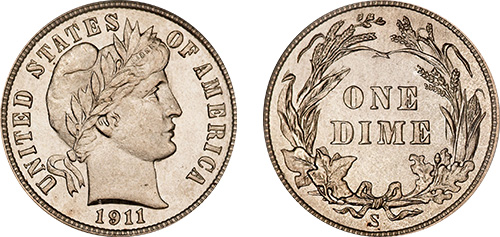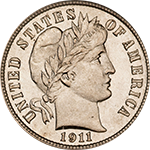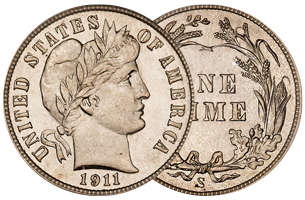The U.S. Mint produced relatively large amounts of these 90 percent silver dimes from 1892 to 1916, for a total of 504 million dimes. Many Barber dimes survived into present times too. That makes this silver coinage a good choice for collectors who seek to acquire an entire series. Moreover, those who don’t mind adding circulated coins to their collections should find the Barber dime a budget-friendly choice to select for a completed collection.
By the late 1870s, the public in Washington and Philadelphia had become dissatisfied with the design of the Seated Liberty. The coin design was considered inferior, and new designs for a silver dime were submitted to the Mint throughout the early 1880s. In 1883, a design by Chief Engraver Charles E. Barber, who refused to let any other engraver assist him, went into production. Barber’s design managed to meet the striking requirements of modern high-speed coin presses, enabling the Mint to strike millions of coins.

The obverse of the Barber dime features the head of Liberty, facing right. She wears a crown fashioned from an olive branch on her head. The Mint also engraved THE UNITED STATES OF AMERICA across the top and the date on the bottom of the obverse side. The reverse features a wreath that circles around the denomination of ONE DIME. The mintmark, if any, is engraved below the wreath on the bottom. Overall, the design is relatively modest when compared to many other U.S. coins.
No mintmark means the dime coin was struck Philadelphia, while S, O, and D stand for San Francisco, New Orleans, and Denver, respectively. Interestingly enough, a total of six different punches were used to engrave the letters. For example, the first punch for San Francisco was the same one used on Seated Liberty dimes, but that branch of the Mint used a wider and fatter punch for the S beginning at some point in 1899. However, some dates and mintmarks, particularly O and S, are very rare in uncirculated condition. Examples of coin varieties that are considerably valuable include the Micro O 1905-S, double-date 1902-O, and repunched date 1893-S. There is also the mysterious 1894-S – one of the rarest coins in US numismatics. It is believed that 24 pieces were struck at the San Francisco Mint, but only 10 specimens can be accounted for today.
The Barber dime coin consists of 90% silver and 10% copper.
These dimes have remained a perennial favorite with collectors for over a century for other reasons besides the large amounts of dimes originally produced. While the Barber dimes were struck from 1892 to 1916, Augustus Heaton, an American author and coin collector, wrote an article called A Treatise on Coinage of the United States Branch Mints as early as 1893, generating public interest in collecting these and other coins produced by the Mint. Furthermore, Barber dimes were the oldest dimes that were still commonly found in circulation by the 1930s, when the first coin folders were sold to the public. This could help account for the fact that many Barber dimes survived when other silver coins were melted down during the Great Depression and World War II.
When compared to many other U.S. silver coins, Barber created a fairly simple design for Barber dime. Art critics rarely mention the Barber dime as a favorite, but collectors like these dimes because of the coin’s silver content and availability. Collectors who want to put together an entire series, and don’t mind adding circulated dimes, might consider collecting Barber dimes.


